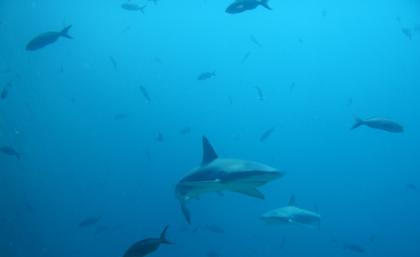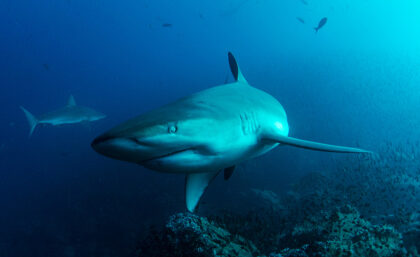
Common name:
Galapagos shark
Scientific name:
Carcharhinus galapagensis
Spanish name:
Tiburón de Galápagos
Conservation status:
Least Concern
Average size:
3 metres
Maximum size:
3.7 metres
Average weight:
85 kilograms
Maximum weight:
195 kilograms
Overview
The Galapagos shark is a species of requiem shark – a family of migratory, live-bearing sharks found in warm waters. Despite its name, the Galapagos shark is found all over the world, but it was first discovered in what is now the Galapagos Marine Reserve. They are quite large for their genus, and have the stereotypically slender, streamlined shark-shaped body. They have 14 rows of serrated teeth that are triangular on the top and sharper on the bottom. Galapagos sharks closely resemble reef sharks and dusky sharks, making them difficult to identify in the field. However their skeletons are very different – the Galapagos shark has 58 vertebrae, whereas dusky sharks have 86-97 vertebrae, and grey reef sharks have 110-119 vertebrae.
Galapagos sharks eat primarily benthic bony fish, but in Galapagos they also predate fur seals and sea lions. They have also been known to be cannibalistic, so young shark pups tend to stay in shallow inland waters, away from groups of adults. Adult Galapagos sharks are very inquisitive, often showing aggression towards fishermen who try to scare them away. Once they become excited, they are difficult to deter, and when they go into a frenzy they may attack anything floating on the surface of the water. Conversely, they often feel threatened in the presence of divers and some other species of shark, taking on a hunched position.
Galapagos sharks in Galapagos
Photo gallery
Click an image to view larger

How you can help
Please help us conserve the endangered sharks of Galapagos by donating today or by adopting a hammerhead shark.
Read more about Galapagos sharks...


2015 Galapagos Symposium: Marine Conservation







